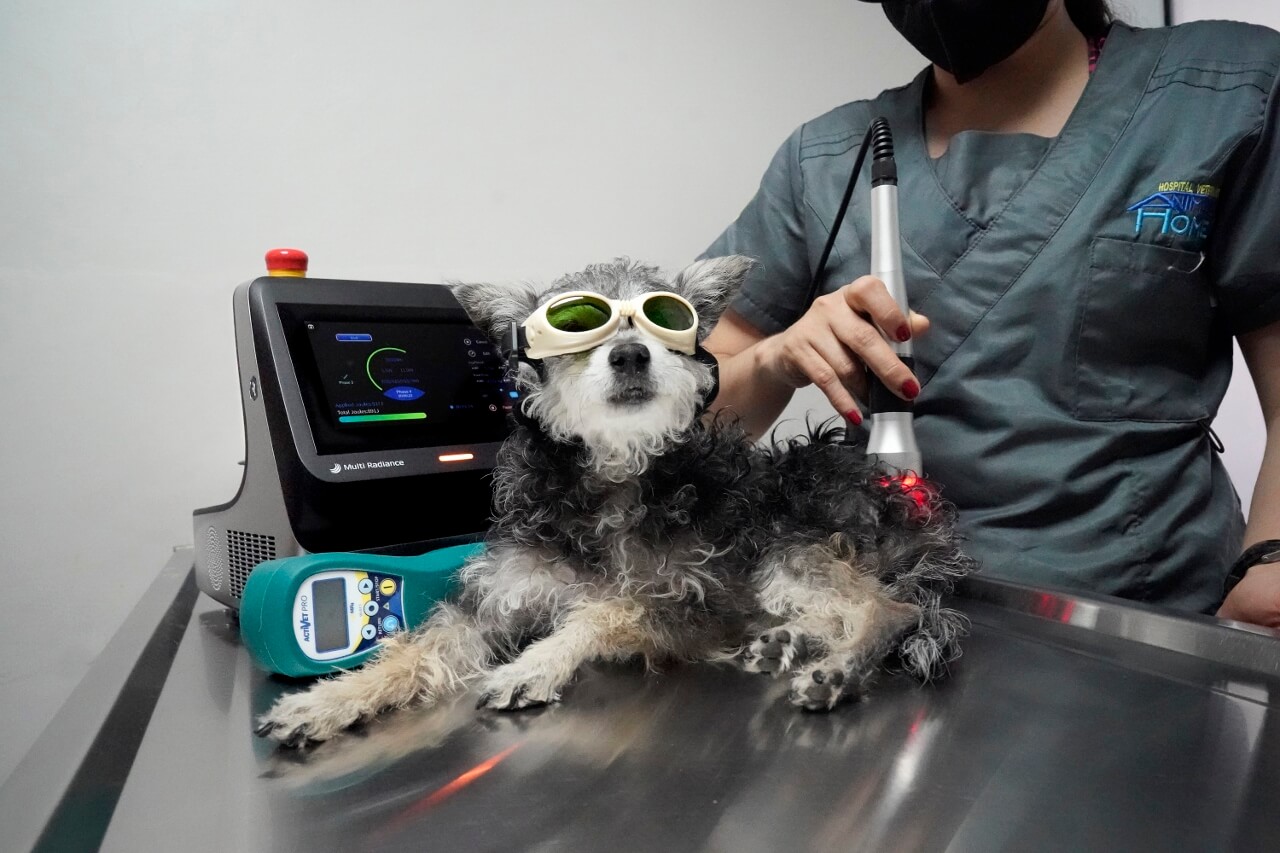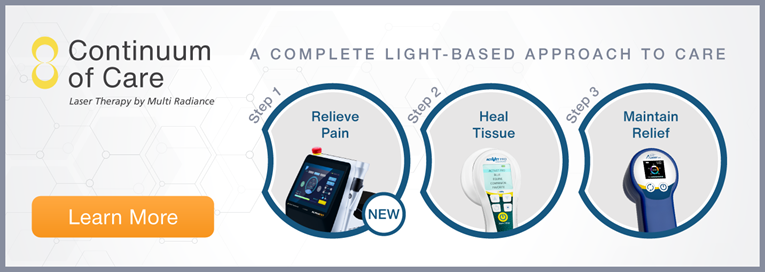Selecting the right laser for the job
Wednesday July 6, 2022

By Iker Asteinza Castro, MVZ, MSc, Dipl
This article originally appeared in the July 2022 edition of Veterinary Practice News.
The use and understanding of laser therapy, photobiomodulation (PBM), has evolved significantly over the past decade. It is built on a deeper understanding of how wavelength, power, and dosage affect specific desired clinical outcomes more efficiently. Today’s devices offer new opportunities for laser therapy to play a larger role in the continuum of care system (CoCS), moving beyond analgesia, and to areas such as dermatology, dental care, and perioperative support.
While the benefits of laser therapy are far reaching, a lack of education of the basic mechanisms of light often limits the scope of its use in clinical practice. For some veterinarians, laser therapy is an integral part of the clinical care plan that can include both in-clinic and at-home care programs. These programs support the pet’s entire journey from injury to recovery, as part of a powerful multi-modal approach to care utilizing light-based therapy.
It is clear several different devices should be considered. The in-clinic care and the at-home devices are different and have different indications for use. One that needs to be powerful enough to deliver quick and effective treatment in clinic, and one needing to comply with safety for use at home by the pet owner. Many veterinary practices only have one laser therapy device, and this may narrow the applications in which laser can be utilized for pet care.
So what device is best for clinical practice? Let’s dig into how to maximize laser therapy beyond pain.
What is a “photoceutical”?
There is a new scientific understanding that light can be delivered like medicine. The photoceutical model of delivering light therapy considers the composition of the therapeutic wavelength (single or multiple), the dose (delivered as power and time), and the dosage (knowing the frequency of application); the clinical effects are determined by absorption of light energy (photons) by specific receptors, ion channels, enzymes, or carrier molecules.1
While all light is composed of photons, the outcomes can be different when different wavelengths and powers are combined—creating different therapeutic applications. In comparison, pharmaceutical medications can be a clear example of adjusting the outcomes by changing the dosage. As an example with glucocorticoids, there are several options, indications and results can vary upon changing dosage, administration route, and more—this is the same for photoceuticals.
Photoceuticals are based on the fundamental concepts of PBM. Absorption of photons by an organelle in the body (a chromophore), can activate a nonthermal process involving endogenous chromophores eliciting photophysical and photochemical events.2
Devices often deliver different doses of light energy (both wavelength and power), thereby creating an optimized device for a specific action in the tissue—this action has historically been analgesia. Laser therapy has changed, and now is not a one-device game. A larger array of clinical benefits can be achieved by exploring new devices that offer tissue healing and repair, antimicrobial effects, and disease management.
Now we have an expanding role and argument for multiple lasers able to deliver high power and super pulsed laser energy both in the clinic and at-home to expand the CoCS. This mix-and-match concept extends to laser therapy in a unique way. Until recently, it was believed a single laser worked for everything. Like other veterinary modalities, such as ultrasound, all ultrasound machines work, but some models lack certain features available like Doppler color or compatibility with transducers, which limits the types of examinations those ultrasounds can perform. The same goes for laser therapy devices—different lasers treat different conditions.
In general, most devices are designed to promote pain control. However, not all work at the same level of analgesia, and newer technologies can promote anti-inflammatory effects, accelerate tissue healing, and provide antimicrobial effects.
This ability to fine-tune outcomes through adequate dosage and proper curative wavelengths is a key component of what makes the concept of photoceuticals unique. Like pharmaceuticals, photoceuticals undergo rigorous clinical trials to establish the proper wavelength and dose optimization settings for consistent and reliable results.
Selecting the right device
A plan of care begins with SOAP (subjective, objective, assessment, and plan) to identify the problem list and establish the treatment goals.3 It is often a mistake to consider a one-size fits all approach to care.
The same mix of pharmaceuticals and therapies will not work the same for every patient. We have more tools than ever at our fingertips and should have a solid stable of both noninvasive therapies and drugs that we can combine to find the right solution for each patient. By also prioritizing the desired clinical outcomes, we can utilize a photoceutical to achieve a maximum benefit of care provided by selecting the most appropriate device.
Leveraging a multi-modal approach finds treatment synergies for patients and seeks to reduce the dose and side effects of drugs. Each unique photoceutical device supports the body’s natural healing process by creating the best environment for cellular recovery. A photoceutical approach to care plays an important role in the optimization of treatment across the entire CoCS:
- Phase 1: Relieving acute pain
- Phase 2: Accelerating tissue recovery/anti-inflammatory
- Phase 3: At-home acute treatment and chronic long-term care
Phase 1: Relieving acute pain
In the first phase of CoCS, the primary photoceutical goal is to get pain under control—fast! After a thorough diagnosis, develop a combination approach of pharmaceutical and photoceutical to provide quick pain relief. Analgesia is often managed with infrared lasers (wavelengths above 800 nm) and is one of the most common wavelengths found in devices.
High-powered lasers seem to have higher efficacy in reducing pain, while low-level laser has shown good published results, the class 4 device works very quickly, is easy to use, and has profound effects on analgesia, making them an ideal go-to in the first step of mitigating pain.4
High-powered laser is also very effective at reducing chronic pain associated with degenerative osteoarthritis.5 This approach to treatment delivery quickly induces analgesia that can be used in alliance with medication and rehabilitation.
Phase 1 care requires more frequent visits to closely monitor the pet to determine the response to the pharmaceutical and photoceutical plans of care. This allows for adjustments and monitoring when the patient is obtaining a satisfactory pain control regimen to then move into the second stage of care—tissue repair or healing.
Phase 2: Accelerating tissue recovery
During the second phase of CoCS, our goal is to repair tissue, reduce edema and inflammation, and wean the patient off pharmaceutical treatment, if it is possible, or promote a synergy in photoceutical and pharmaceutical treatments to reduce the side effects of medication in the patients. If the pet does not respond well and goes back into crisis (ex. osteoarthritic patient), return to Phase 1 of CoCS increase or change the photoceutical treatment and pharmaceutical dose administered.
When the pet is out of pain, attempt to move into Phase 2 of care with a more aggressive photoceutical approach to minimize the chances of a return to acute pain, strengthen muscles, relax the back, and laser compensatory zones.
At this step, the main priority is supporting the healing of tissue by reducing inflammation, and edema, thereby accelerating tissue repair. As pain control is now a secondary consideration (often pain persists due to the presence of inflammation), the photoceutical devices need to deliver anti-inflammatory effects rather than analgesic.
In this second phase of care, veterinarians can focus on reducing the impact of inflammation on the body, improving blood flow to the affected area, and providing energy in the form of increased adenosine triphosphate (ATP) to accelerate healing on a cellular level.
While high-powered lasers work fine on analgesia, there is a great deal more evidence on the reduction of inflammatory and oxidative stress utilizing super pulsed lasers.6 As a part of the CoCS, photoceuticals are designed to include wavelengths that focus on photochemical changes in the tissue (optimizing and promoting mitochondrial respiration) that improve cellular energy stores needed to promote healing and resolve inflammation.
This stage of care also incorporates rehabilitation, addressing the needed increase in muscle strength and pain-free range of motion. As the patient feels better, gradually we will be able to space out the therapies and eliminate or lower the doses of medications. This is a great time to consider an at-home photoceutical to continue to support the rehabilitation goals of returning to function. These at-home treatments serve as a “booster” during this phase to ensure the patient continues to recover and to ease any discomfort felt as activity is increased.
Phase 3: At-home acute treatment and chronic long-term care
The most important factor in the CoCS is pet owner compliance. Unfortunately, many pet owners are too busy to visit the clinic for multiple long-term care, maintenance, or preventive treatments. Chronic conditions usually come with client education for some type of home therapy. For example, with osteoarthritic patients, weight control recommendations, exercise plans, ongoing therapies, and preventive measures keep these pets on the road to recovery.
Veterinarians can provide both high-powered and super pulsed lasers in the clinic but expand care with an at-home device for pet owners to deliver additional treatments in between in-clinic sessions. At-home photoceutical approaches to care provide an easy way for pet owners to comply with their pet’s plan of care.
This approach gives the pet the benefit of potentially two treatments per day during this phase of care to relax muscle tension, reduce edema and pain, and promote tissue healing like fracture remodeling.
At-home lasers enable pet owners to provide complementary treatment for chronic conditions like osteoarthritis, both as a long-term and preventive treatment. For example, pet owners can pre-treat when winter weather is beginning in order to encourage better range of motion and prevent injury, and sports dogs can be treated before and after training to minimize the injury risk.
Pet owners feel good about participating in their pets’ care and remain compliant as they see the results first-hand. At-home care is a win for patients, pet owners, and practices. While this photoceutical is not the right solution for every condition (remember, we are selecting the right tool for the job at hand), it is a good supportive tool in a multi-modal plan of care and as a booster treatment between office visits.
The future of photoceuticals
It’s rare that veterinarians have the luxury of extrapolating human research into animal applications. Typically, we are taking results from studies done on rats and trying to turn them into practical applications for our patients, but in the case of photoceuticals, we can take advantage of the wide body of existing research on human patients.
In the next five to 10 years, photoceutical care will be as standard as X-ray and ultrasound in veterinary practices. This approach supports current standards of care and has incredible potential to reduce drugs needed to control pain.
In conclusion, laser therapy has been effectively used for many years in veterinary medicine. What we have learned, just like a pharmaceutical approach to care, it is not a one-size-fits-all approach. With the evolution of lasers within the CoCS, you now have access to multiple lasers for each stage of care; pain management, acute care/tissue healing, and at-home, long-term care. It is important to have options at each stage of the process.
Iker Asteinza Castro, MVZ, MSc, Dipl. Small Animal Medicine and Surgery, has more than 20 years of experience in private veterinary practice. He owns two reference veterinary hospitals for small animals with veterinary specialties and has served as an associate professor in the small animal department at Universidad Del Valle de Mexico since 2014. Dr. Asteinza is a founding member of the board of the Mexican Association of Veterinary Hospitals, as well as a medical advisory board member with Multi Radiance Medical and a veterinary expert with Laser Therapy University.
References
- Schenone M, Dančík V, Wagner BK, Clemons PA. Target identification and mechanism of action in chemical biology and drug discovery. Nat Chem Biol. 2013;9(4):232-240. doi:10.1038/nchembio.1199.
- Anders JJ, Lanzafame RJ, Arany PR. Low-level light/laser therapy versus photobiomodulation therapy. Photomed Laser Surg. 2015;33(4):183-184. doi:10.1089/pho.2015.9848.
- Podder V, Lew V, Ghassemzadeh S. SOAP Notes. [Updated Sep 22021]. In: StatPearls [Internet]. Treasure Island (FL): StatPearls Publishing; 2022 Jan. Available from: https://www.ncbi.nlm.nih.gov/books/NBK482263/
- Riegel, R. J., & Godbold Jr, J. C. (Eds.). Laser Therapy in Veterinary Medicine: Photobiomodulation. 2017. John Wiley & Sons.
- Angelova A, Ilieva EM. Effectiveness of High Intensity Laser Therapy for Reduction of Pain in Knee Osteoarthritis. Pain Res Manag. 2016;2016:9163618. doi:10.1155/2016/9163618.
- Hamblin MR. Mechanisms and applications of the anti-inflammatory effects of photobiomodulation. AIMS Biophys. 2017;4(3):337-361. doi: 10.3934/biophy.2017.3.337. Epub 2017 May 19. PMID: 28748217; PMCID: PMC5523874.


